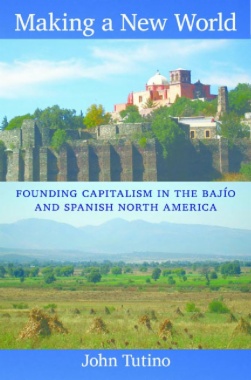Making a New World is a major rethinking of the role of the Americas in early world trade, the rise of capitalism, and the conflicts that reconfigured global power around 1800. At its center is the Bajío, a fertile basin extending across the modern-day Mexican states of Guanajuato and Querétaro, northwest of Mexico City. The Bajío became part of a new world in the 1530s, when Mesoamerican Otomís and Franciscan friars built Querétaro, a town that quickly thrived on agriculture and trade. Settlement accelerated as regional silver mines began to flourish in the 1550s. Silver tied the Bajío to Europe and China; it stimulated the development of an unprecedented commercial, patriarchal, Catholic society. A frontier extended north across vast expanses settled by people of European, Amerindian, and African ancestry. As mining, cloth making, and irrigated cultivation increased, inequities deepened and religious debates escalated. Analyzing the political economy, social relations, and cultural conflicts that animated the Bajío and Spanish North America from 1500 to 1800, John Tutino depicts an engine of global capitalism and the tensions that would lead to its collapse into revolution in 1810.
- Contents
- Maps and Illustrations
- Prologue: Making Global History in the Spanish Empire
- A Note on Terminology
- Introduction: A New World: The Bajío, Spanish North America, and Global Capitalism
- Part I: Making a New World: The Bajío and Spanish North America, 1500–1770
- Chapter 1: Founding the Bajío: Otomí Expansion, Chichimeca War, and Commercial Querétaro, 1500–1660
- Chapter 2: Forging Spanish North America: Northward Expansions, Mining Amalgamations, and Patriarchal Communities, 1590–1700
- Chapter 3: New World Revivals: Silver Boom, City Lives, Awakenings, and Northward Drives, 1680–1760
- Chapter 4: Reforms, Riots, and Repressions: The Bajío in the Crisis of the 1760s
- Part II: Forging Atlantic Capitalism: The Bajío, 1770–1810
- Chapter 5: Capitalist, Priest, and Patriarch: Don José Sánchez Espinosa and the Great Family Enterprises of Mexico City, 1780–1810
- Chapter 6: Production, Patriarchy, and Polarization in the Cities: Guanajuato, San Miguel, and Querétaro, 1770–1810
- Chapter 7: The Challenge of Capitalism in Rural Communities: Production, Ethnicity, and Patriarchy from La Griega to Puerto de Nieto, 1780–1810
- Chapter 8: Enlightened Reformers and Popular Religion: Polarizations and Mediations, 1770–1810
- Conclusion: The Bajío and North America inthe Atlantic Crucible
- Epilogue: Toward Unimagined Revolution
- Acknowledgments
- Appendix A: Employers and Workers at Querétaro, 1588–1609
- Appendix B: Production, Patriarchy, and Ethnicity in the Bajío Bottomlands, 1670–1685
- Appendix C: Bajío Population, 1600–1800
- Appendix D: Eighteenth-Century Economic Indicators: Mining and Taxed Commerce
- Appendix E: The Sierra Gorda and New Santander, 1740–1760
- Appendix F: Population, Ethnicity, Family, and Work in Rural Communities, 1791–1792
- Appendix G: Tributes and Tributaries in the Querétaro District, 1807
- Notes
- Bibliography
- Index

